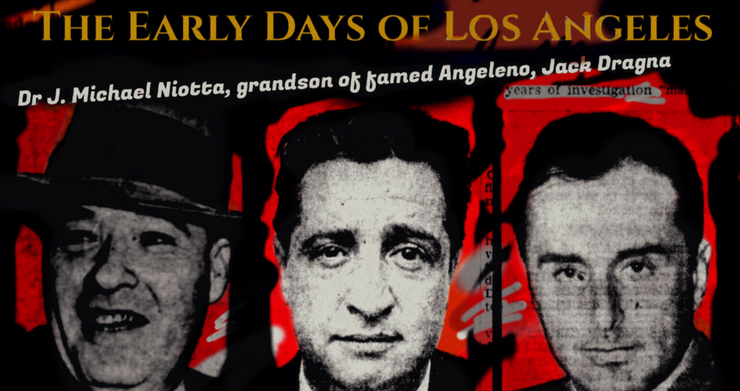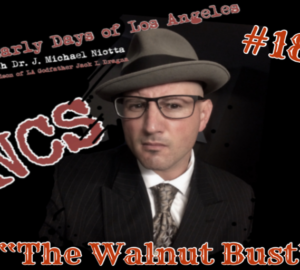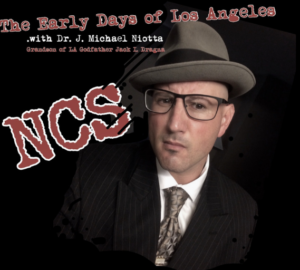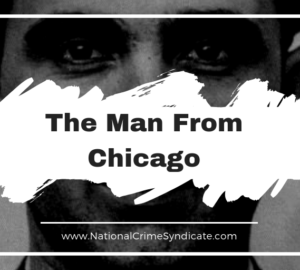16 minutes
Installment 12: The East in the West
Author’s Note: Before my last installment I took a poll to find out which Willie you wanted to see—Bioff or Moretti. Willie Moretti won the bout and appeared in NCS 11. Now you’ll get a taste of Bioff as well, so hopefully everyone’s happy. Keep on the look out for video clips from my recent panel on early Los Angeles mob activity at the Mob World Summit at the Plaza Hotel in Las Vegas. There’s a clip up now on www.jmichaelniotta.com and more will be coming. Enjoy this new installment; it covers a very touchy and controversial subject—the East versus the West.
Crime writers, bloggers, and mob aficionados are quick to spout Eastern gangsters lorded over the Los Angeles rackets. Typically, menacing words like “encroachment” are used to make claims of weakness or fear among Western “racketeers.” Allegedly everyone out West meekly buckled to the whims of others. According to such tales, when the LA Family wasn’t subservient to New York’s syndicated “boss,” Benjamin “Bugsy” Siegel, they fell under the thumb of the Windy City’s “old Capone mob.” In response to this, it smells like that wind coming in is just a little too fishy.
Lack of insight no doubt accounts for at least some of these misconceptions. And I’ll do my part to make what I can known. That aside, the question still remains—what was the East’s stake out West? And why were they in Los Angeles in the first place?
Before attempting to answer, I’d like to highlight an important fact. In the history of the LA Family, the only known “homegrown leader”—as in an individual actually born and raised in the state of California that assumed the role of “Boss”—was a cousin of mine, Luigi “Louie” Tom Dragna. And technically, Louie only sat in briefly as an Acting Boss. Joe Ardizzone, the Matrangas, and Vito DiGiorgio all spent time in Louisiana before voyaging over to the sunshine of the Golden State. And like them, before ever reaching Colorado, Rosario DeSimone hung his hat in New Orleans. The younger DeSimone, Frank the lawyer, was born during the family’s time in Pueblo. Jack Dragna grew up in East Harlem and rubbed elbows with the other Corleonese (Reina-Gagliano-Lucchese) before making the trip out West, while Nick Licata and Dominic Brooklier did business in Detroit. Lastly, Peter Milano and his family came out of Cleveland. The reason for this is simple; the boats didn’t sail to California. They landed in the Port of New Orleans and at New York’s Ellis Island. The point is—ALL of the Italians who conducted business in Los Angeles during the early days started out back East. Just like the individuals allegedly “encroaching,” they too “invaded” to make a life and a living.
I’m confident this morsel of truth won’t suffice as the grand explanation to soothe the masses. But perhaps sprinkling some more of the backstory might help. To unearth the unknown, an explanation of how the rackets in question tied specifically back East is in order. Generally, there are two big incidents that come to mind when the subject of an Eastern “intrusion” on Western turf is mentioned. These are outside involvement in SoCal companies that provided horse-racing information (the wire), and Chicago’s shakedown of the Hollywood studios. Ben Siegel is always the biggest New York presence named. And in regard to the Windy City, Johnny Roselli is continually referenced.
The Wire
Installment 6 of The Early Days of Los Angeles—“Prelude to the Kefauver Hearings”—touched upon Gene Normile’s presence in SoCal prior to Roselli’s arrival and his integral role in the West Coast racing wire. Normile—the former manager of boxer Jack Dempsey—held a stake in Mexico’s Agua Caliente Race Track before California re-legalized parimutuel wagering. Having an association with racing information industry mogul, Moe Annenberg, and already being a part owner in the Tijuana track, Normile naturally went in on the wire.
Johnny Roselli was another individual who owned a percentage of the track and the wire. During the Kefauver Hearings, he expressed that he worked with Normile in SoCal during the first half of the thirties, then also divulged that he briefly had dealings with Normile’s successor, Russel Brophy. An earlier report given to a different committee offered a slight variation to this story. Los Angeles Police Captain Lynn White claimed that Handsome Johnny muscled Normile for a percentage of the profits. And because Roselli is always assumed to be a Chicago emissary, folks quickly leap to the conclusion that the old Capone mob owned this interest in the SoCal wire and the Tijuana track. Whether or not they did, there is more than merely Roselli that ties Chicago to the sport of horse-racing in California.
Normile, like Jim Coffroth before him and later Brophy, managed and co-owned a subsidiary of the wire. Think of the subsidiary as just one leaf on a very large and bushy tree. Now picture the parent company as the trunk of that tree. The task of each leaf (subsidiary) was to gather the race results from the racing establishments in their given region. As soon as the horses crossed the line, the outcome went out over the wire. Think of it as a precursor to G-Mail. Similar to a fax, a teletype machine allowed for the information to be printed on the other end almost immediately. In addition to relaying the winners, subsidiaries also offered up track conditions and other details that were added into a gambler’s favorite buddy—the scratch sheets. Bettors looked to the sheet for odds, facts about a specific horse or jockey, statistics, and other seemingly important knowledge about the sport. Many gamblers believed the sheet provided them with an edge, that it added an art or skill to what was—in reality—little more than a game of chance.
Serving as a hub, the trunk took in the results from across the country. Acting just as promptly as its foliage, the trunk packaged the inside word from a nation’s worth of leaves. This “finished product” then spewed out to customers. Subscribers—typically bookies who took unsanctioned (illegal) bets outside of the park (aka the term offtrack betting)—paid for the fruit produced by the tree. Considering the bookies who lacked fruit in their diet went broke fast, it could honestly be viewed as a tree of knowledge. Without the wire’s real time results, a bookmaker might as well have been giving away his money. Here’s one scam. A bettor has a pal down at a track in some other city. This pal calls the bettor the moment the winning horse finishes. If the bettor targets a bookie that he knows isn’t a subscriber then he may be able to place a bet on the winner before the bookie even knows the race was over. Jackpot!
The racing wire was far more syndicated than any bootlegging operation. The trunk relied on its leaves just as heavily as everyone else in the chain. Gamblers, bookies, and Shylock lenders—with every race they all potentially stood to make loads of cash, but only if the setup worked. Not only was it a symbiotic relationship, it was one that demanded a high level of coordination and communication.
The parent company serving these bookies and gambling establishments (providing the fruit they were after), did so on a national level, hence one iteration of the corporation’s name—Nationwide News. Over the years the dominant wire provider wore several names and found itself managed by various owners. Prior to Nationwide the letterhead read General News Bureau and toward the end most folks called it Continental. And this is where the Windy City comes in.
The Outfit’s attempts to cut into the action went back a number of years, and chiefly because of location. The tree trunk that wore a country’s worth of leaves had called Chicago its home since roughly the start of the century. Because the hub nestled in the Outfit’s turf, it made perfect sense that they’d have an inherent interest. And they did. They’d been hounding and threatening for a piece of the take unsuccessfully since the beginning. To clarify, the lion share of all this muscling took place in the state of Illinois.
The Outfit went after Chicago gambling figure Mont Tennes then leaned on newspaper tycoon Moe Annenberg. Allegedly Moe agreed to shell out a million a year for “protection” but the arrangement didn’t last. Ownership of the wire changed hands soon after and unfortunately the new reigning mogul wasn’t prone to sharing. This top man was a Chicago gangster, not some scared suit they could easily muscle. Attempts to reason with James Ragen Sr. proved futile. He wouldn’t give them what they wanted. Gunmen mowed him down in Chicago in August of 1946. A tough character, Ragen didn’t kick it. And when it looked like he might actually pull through, the Outfit snuck into the hospital to follow up; they finished the task by slipping mercury into his beverage.
After decades of resistance, Chicago finally landed a wire owner who got the message. It may have taken a long time, but the Outfit eventually got what they were after. Quick to quietly buckle was Arthur McBride’s son, Eddie—the college boy who took over shortly after Ragen’s nasty departure. With McBride in the saddle, Capone’s old crew got the taste they were long after.
Getting back to the East in the West, without coordination, the tree couldn’t produce a viable fruit. And without that everyone went hungry. Sans the imagery, Chicago couldn’t make any money off their new baby unless they had a business arrangement with each of the subsidiaries. This should explain Chicago’s interest in and communication with Los Angeles and San Diego. But the “old Capone mob” wasn’t dealing solely with Southern California; they coordinated with “racketeers” all over the country on the endeavor. This activity taking place all over remained fairly quiet. What likely helped was the big splash made by a well known character, Benjamin “Bugsy” Siegel.
Achieving the goal of tapping into the wire years earlier than their Eastern brothers, were SoCal gambling czars Jack Dragna and Johnny Roselli. Normile’s ten or so percent had been coming in faithfully since the middle-thirties. But now with their friends in Chicago silently stringing the figure-headed puppet, they would be receiving a much larger portion. Family heads throughout the United States also stood to gain from the takeover. Confounding this arrangement; however, was a second wire service which had sprouted to compete.
Trans-American wire service came into existence simply because the dominant provider refused to be muscled. In ‘46, when Chicago laid Ragen to rest and finally got a hold on the industry, Trans-American was still just getting situated. Although its development began prior to the Japanese surrender, they hadn’t really accomplished all that much. The service is most often associated with Benjamin “Bugsy” Siegel and yet, in the year before his murder, his Flamingo Hotel & Casino was still receiving its race results from the competitor—Continental. Though Hollywood commonly pits Ben Siegel and Jack Dragna as bitter rivals, the pair actually worked together in building Trans-American out West. Hindering the success of their project was another endeavor set on the same timeline; Ben’s preoccupation with the Flamingo. Problems with construction and funding kept Siegel from taking care of business with the wire. This left Jack with the difficult task of trying to make it happen for the entire coast with little support.
Despite the collaboration, Jack and Ben’s quest was near un-winnable from the start. Nationwide may have changed names to Continental, but each of its subscribers knew it as the dominant provider. The service really was that reliable. Being that tried and true, subscribers didn’t want to go elsewhere. Trans-American’s efforts to take the lead could be compared to the plight of grocery brand soda challenging the almighty Coca Cola. Frankly, it wasn’t going to happen. Continuing with the imagery, the subscribers who did partake in the new product were not willing consumers.
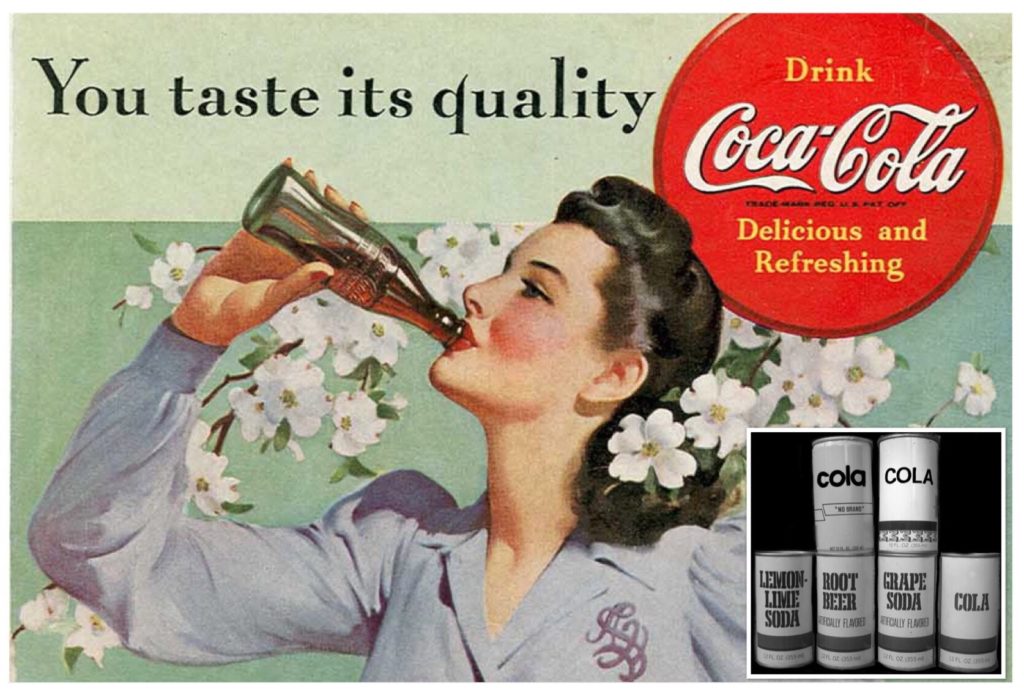
As a corporation, Trans-American had a variety of investors and all of them shared the same goal—to make money. Whether they achieved this with Trans-American or Continental, it mattered very little. And so, once Chicago got a stranglehold on the trunk, the need for twin leaves out West sounded redundant. Trans-American was slated for evaporation. Feeling entitled to compensation for his efforts in the newer service, Ben Siegel fought against this decision. One man against the group. Some have intimated that he even demanded to be bought out. Self-consumed, his efforts were not in line with the interests of the whole.
Whether or not the Flamingo’s failure had anything to do with it, the West Coast leaf was placed into the hands of Jack Dragna. And I’m sure Ben Siegel wasn’t happy about this decision either. There wasn’t a whole lot of fuss made by the other investors though; perhaps they were smart enough to grasp the larger picture. Muscling the leaves in their own arenas, each of them would make good money. Whether or not Chicago behaved in a generous matter, wasn’t the issue. Everyone involved understood that the Outfit’s success depended upon combined efforts. After all, unless you’re Ikea, you can’t sell a product that isn’t assembled. It was a symbiotic relationship to say the least. Each of the “top hoodlums” nationwide would be receiving their cut for handling the track information in their given turf then supplying it quickly to the hub in Chicago for dissemination.
Johnny Roselli
Before diving into the Hollywood union fix, I’d like to address the topic of Johnny Roselli. To some extent, I’ve already tackled this. NCS 5, “The Curious Allegiances of Handsome Johnny,” goes into great detail about the Roselli saga and hacks away at Charles Rappleye and Ed Becker’s biography, All American Mafioso. I’d like to go further now, and I’d also like to throw another acclaimed book beneath the lens. The side-bar is warranted, considering the ideology of a Chicago encroachment on Los Angeles turf takes its strength from the contention that Johnny Roselli (who lived in LA for roughly over half a century and was never a resident of the state of Illinois) operated under orders from Chicago.
Although it only offers a post World War II view of events, The Last Mafioso—Ovid Demaris’ bestseller about hitman Jimmy “the Weasel” Fratianno—has long been considered the definitive insider story on LA’s Italian underworld. When reading the bio offered on Johnny Roselli though, it becomes dicey in regard to where the Weasel’s words go thin (or perhaps silent) and “artistic liberties” take over.
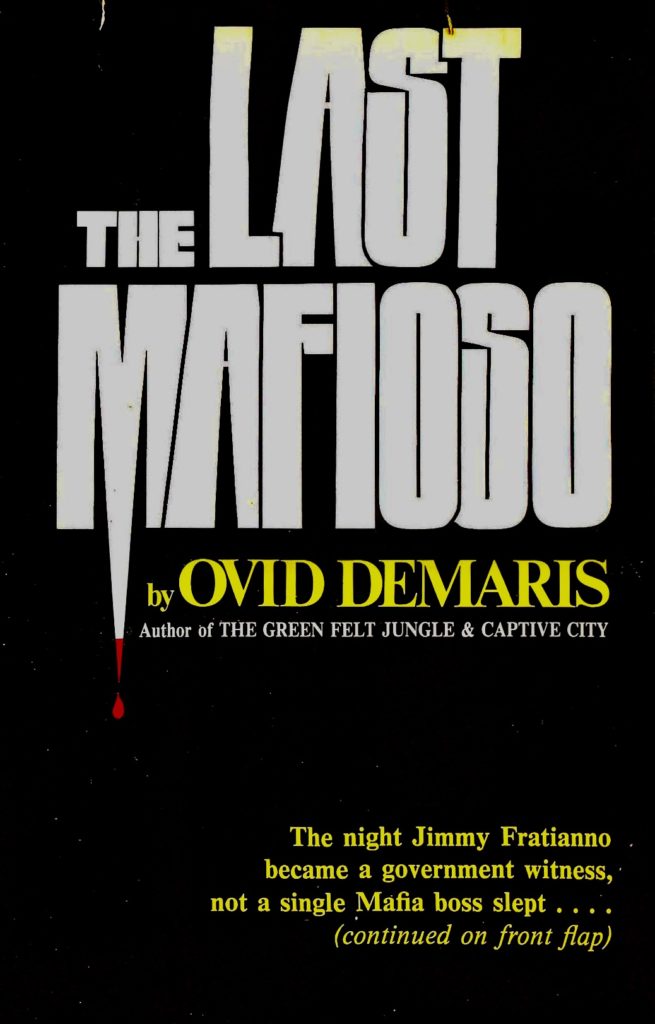
Demaris approached the book in a way that makes it difficult—and at times even impossible—to discern between Fratianno’s narrative and Demaris’ agenda. This clever approach has kept a lot of folks from challenging his assertions. Keep in mind that Jimmy Fratianno admitted that he never even read The Last Mafioso. On the point in question—Johnny Roselli’s allegiances—the reader takes in two contradictory narratives. One section makes the claim that Roselli took his orders directly from Chicago. This has been repeated word for word again and again—especially by enthusiasts of the Outfit. Confounding this contention (which probably wasn’t even made by Fratianno in the first place) are a pair of statements that appear later.
In the Weasel’s recap of his ceremonial induction into la cosa nostra, he provides a very pertinent statement spoken by Handsome Johnny:
“Jimmy, Jack Dragna’s the boss of OUR family.”
Another indicator in line with this contention arrives later in the text, when Fratianno explicitly states that Johnny Roselli transferred membership to the Chicago Outfit shortly after the death of Jack Dragna. It may be elementary to point out, but I’m going to do it anyway. In order to transfer FROM a family, you need to belong TO that family.
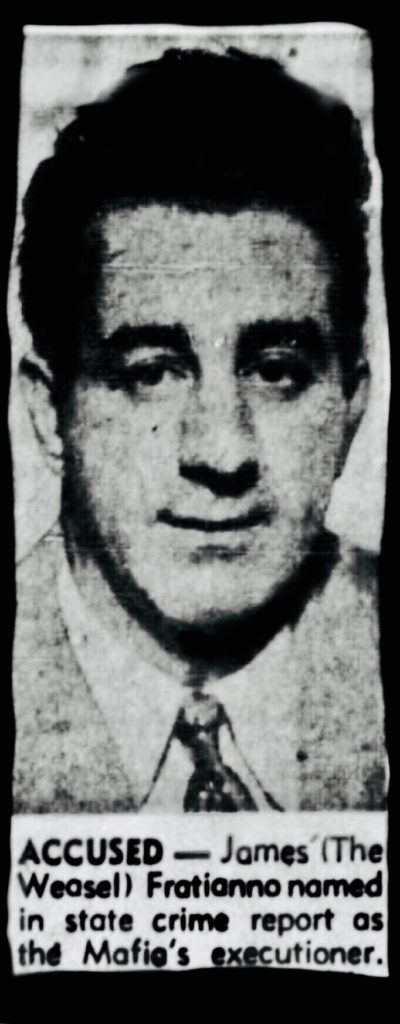
Some might say (and this is me saying it) that as added flair to sell more copies, and in order to fill in all the historical holes Jimmy had no deep knowledge of, Demaris implanted his own (dated) research. Here is a passage from The Last Mafioso. Readers are led to believe this is something Handsome Johnny said face to face to Jimmy the Weasel, but it really wasn’t. That being said, that never stopped the words from being quoted and bowed to over and over. But now they go beneath the blade for a much needed dissection. Catch the rebuttal in bold.
…as a kid he had been tough enough to make it with Capone at a time when tough guys were dying like flies. ACCORDING TO ROSELLI’S UPDATED FBI FILES, HE GREW UP IN BOSTON AND IN 1923 HE SPENT ROUGHLY THREE MONTHS IN CHICAGO BEFORE REACHING LOS ANGELES. HE WAS JUST 17 AT THE TIME. ROSELLI’S RETURN TO CHICAGO IN 1927 WAS ALSO EXCEEDINGLY BRIEF—A MERE VISIT. HIS BOOTLEGGING ACTIVITIES (1923 TO 1934) OCCURRED IN CALIFORNIA Later when Capone went to prison, Roselli took his orders from the new Chicago boss, Frank Nitti. Roselli was then dispatched to California, IT’S HARD TO DISPATCH SOMEONE SOMEWHERE THEY ALREADY LIVE! CAPONE WENT TO PRISON IN 1931. ROSELLI HAD BEEN LIVING EXCLUSIVELY IN SO CAL SINCE 1923 AND WORKING IN JACK DRAGNA’S BOOTLEGGING OPERATION SINCE ‘27 OR ‘28. PRIOR TO THAT HE WORKED IN LOS ANGELES FOR TONY CORNERO. ALTHOUGH ITALIAN, CORNERO WASN’T CONNECTED where his job was to protect Nationwide, then the only horserace wire service in the country ROSELLI WAS IN LA FOR A DECADE BEFORE BECOMING INVOLVED WITH THE RACING WIRE, AND HIS CONNECTION TO THIS SERVICE WAS PUBLIC RECORD. NEWSPAPERS OUTLINED IT PRIOR TO THE KEFAUVER HEARINGS AND ROSELLI EVEN SPOKE ABOUT HIS PART IN THE BUSINESS DURING HIS TESTIMONY.
Up until the sixties, Feds thought Roselli was born in Chicago. So did newsmen. By the time anyone learned different, Handsome Johnny had already made the switch to that family. Having a gripe with the new leadership in LA, he transferred from the Los Angeles Family to Chicago’s faction. Although this didn’t happen till the second half of the fifties, the newspapers had long been preaching another story. According to reporters, he’d been an Al Capone gangster since at least the early forties. Reason for this is simple. In the early 40’s, Roselli went away with a handful of bonafide Chicago operators. Together, they served a stretch of reeducation over the extortion of some big time Hollywood studio executives.
Hollywood Union Shakedown
The second incident that typically receives attention when the issue of an Eastern presence in Los Angeles is mentioned is also Chicago related. There are a lot of intricacies to this caper, and in the short page of material that follows, all you’re really going to get is a little insight into why an East Coast Jew was fronting for some Chicago Italians; and why the hell they were doing it out in Hollywood.
Going back to the first half of the thirties, Willie Bioff called the shots for a union that represented movie studio stagehands. When he first stepped into this role; however, he was doing it in Chicago! According to federal files, “In about the middle 1930’s, BIOFF approached NITTI for his assistance in taking over the leadership of the CHICAGO local of the International Alliance of Theatre and Stage Employees (IATSE).” Getting an in in Chicago, they decided to take the racket further. They plotted to gain “the ultimate control of that union, nation-wide.” The ploy brought Bioff and a handful of Chicago men to the source; the land where the biggest and best pictures were being filmed—Hollywood. Their foot was in the door by the middle of the decade.
Caribou County Sun, December 7, 1934
LABOR: Film Strike
Whether A, F, or L movie unions are powerful enough to shut down 20,000 U.S. film theaters is a question no movie producer is anxious to test. Directed by William Bioff (who Chicago authorities sought on a 17 year-old pandering conviction) studio unions in Hollywood demanded a 10 per cent wage increase and threatened to close theaters if it was refused.
In regard to the strength of this fix, it is paramount to highlight this union included projectionists. These individuals sitting in the dark little rooms in the back of theaters all across America were responsible for showing every single film that patrons viewed. You could not watch a movie without them. And back then, the job took a fair amount of skill. Any use of scabs during a picket would have been exceedingly limited. Monetarily, a projectionist walk-out stood to land a HEAVY hit to the motion picture industry. Wielding this threat like a postured nuke, Bioff and his union partner, George Browne, flexed their power. “When control of this union was consolidated,” as FBI files explain further, “demands for large sums of money were made to the owners and big producers of the motion picture industry.” Raking in even more cash, they tapped into the union coffers, siphoning out a portion of members’ dues. As the LA Times put it, “In its palmy days, the Bioff regime’s take from the studio workers was reputed to be as high as $60,000 a month.” The LA Family’s cut of the profits for allowing the activity in their territory remains a mystery. Bioff being an “outsider,” he would not have been privy to any financial arrangement between families. It is likely that, for this reason, the issue never surfaced in a courtroom or the papers.
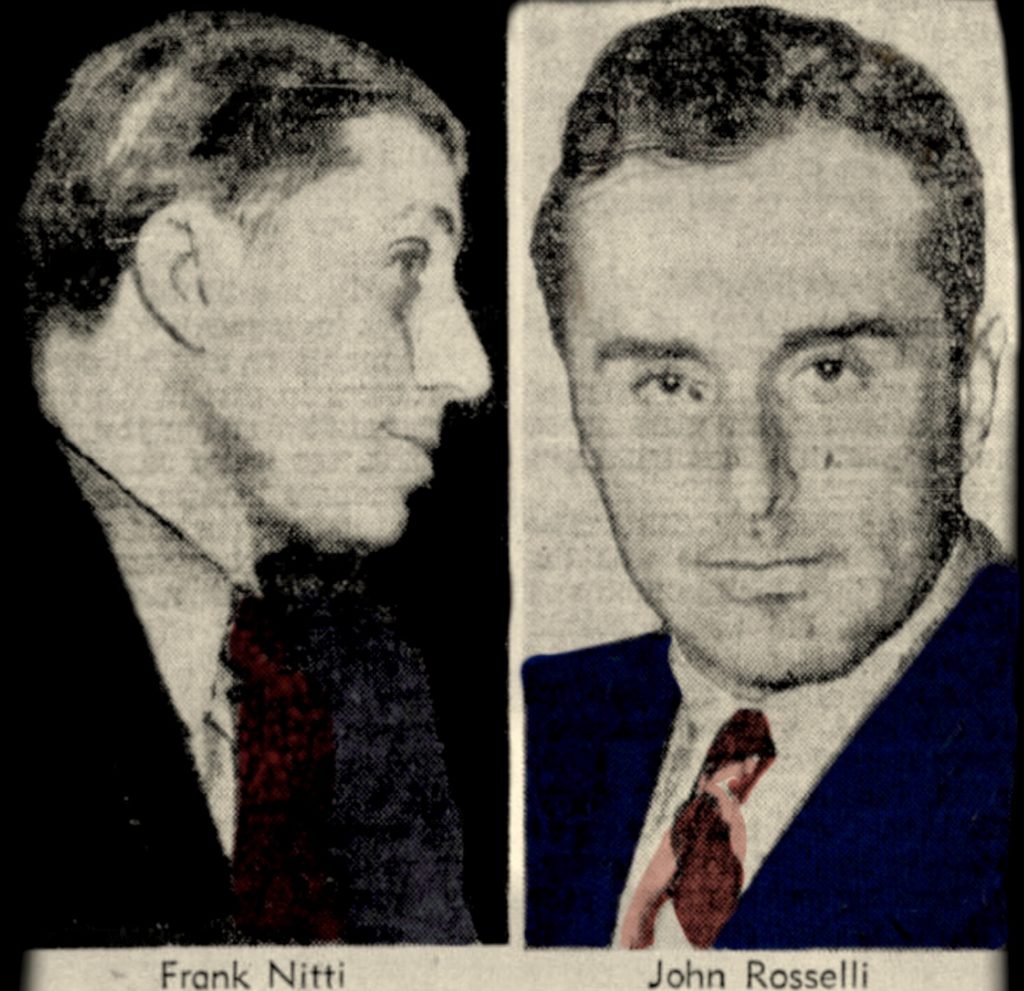
Frank Nitti may have vouched for Bioff, but his fellow Italians weren’t so trusting. To look after their interests, several Chicago Outfit members made the trip to Los Angeles as well. Paul “the Waiter” Ricca, Nick Circella, Phil D’Andrea, Louis Campagna, and Charles “Cherry Nose” Gioe tagged along.
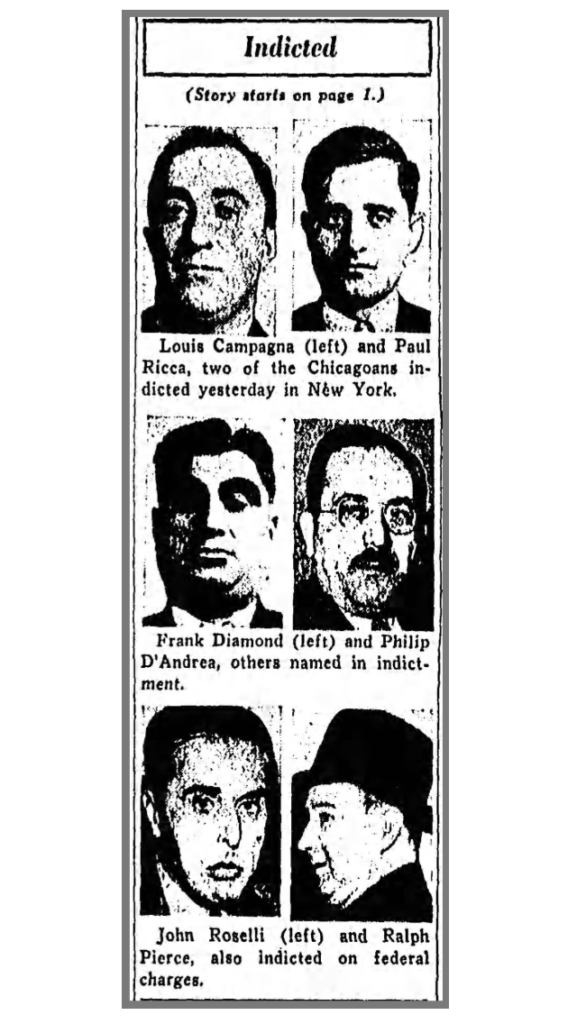
The plan wasn’t to encroach on their West Coast cohorts—though that’s usually what is intimated. The idea was to keep an eye on Bioff and the money. Johnny Roselli’s role in the caper appears slight. Already employed in the movie industry, he knew people and he heard things. Call him a local asset. Looking out for the interests of fellow fraternity members is straight out of the book; that rule goes back to the 1800’s. Plus LA would be receiving a portion of the profits, and they wouldn’t want to jeopardize that action.
When Johnny Roselli caught studio talk that Willie Bioff was headed for trouble, he had a feeling Nitti’s man might talk, so he promptly reached out to Chicago. The assumption was right. Bioff proved to be quite the singer. Unlucky for the lot involved in the caper, all but Nitti ended up in the stew. Dead set against going back to the joint, Nitti chose to take his own life over rotting in a cell. In regard to Handsome Johnny—as Demaris-Fratianno explained it—after he got out, he reunited with Jack and the LA Family.
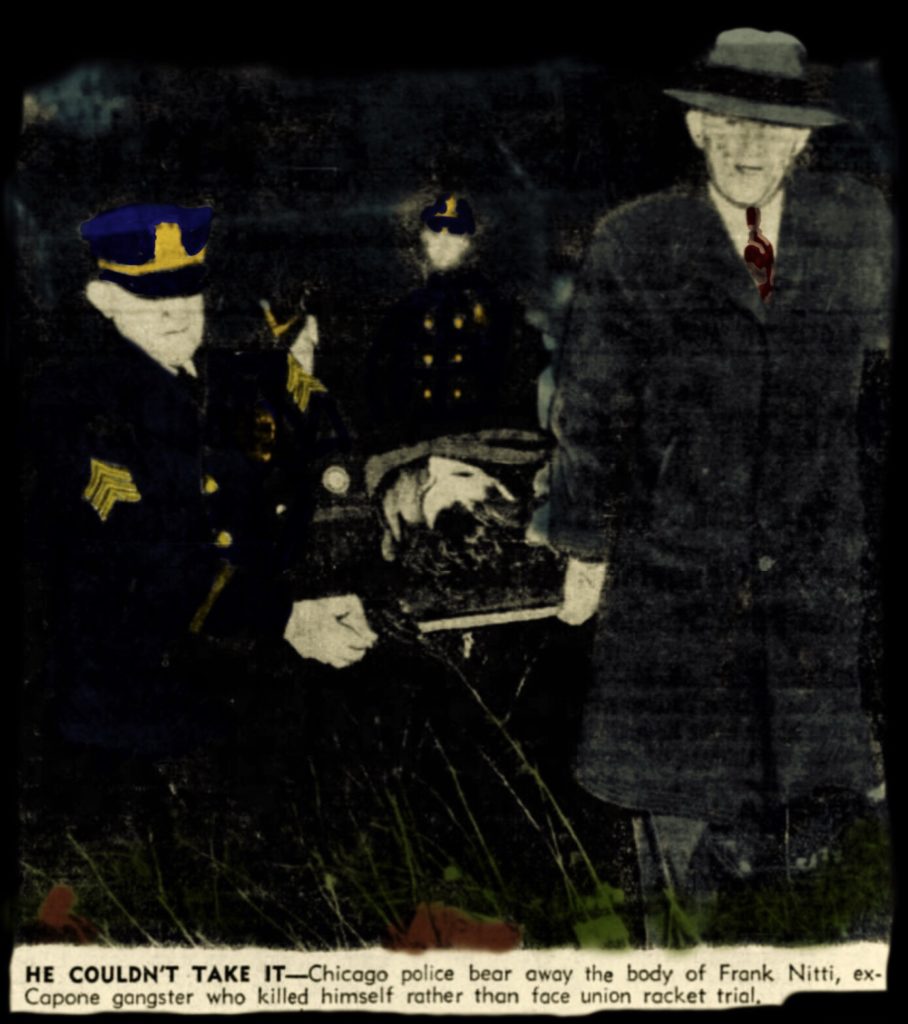
Further reading: For a more in depth history of the racing wire, check out Allan May’s article, “The History of the Race Wire Service.” Though based predominately on newspaper reports, it offers a great amount of insight on the East Coast happenings. Also, I have heard that another book strictly on Johnny Roselli is soon coming. The author is Lee Server.
- The Walnut Bust: The Early Days of Los Angeles With Dr J. Michael Niotta - May 21, 2020
- The Cornero Gang & the Infamous Page Brothers: The Early Days of Los Angeles With Dr J. Michael Niotta - June 4, 2019
- The Man From Chicago: The Early Days of Los Angeles With Dr J. Michael Niotta - December 12, 2018






